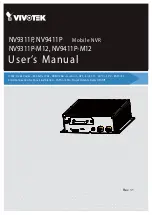
76
3.11.1.3 Encode
It is to set video bit stream, picture bit stream, video overlay parameter and etc.
3.11.1.3.1 Video
Video setting includes the following items. See Figure 3-75.
Channel: Select the channel you want.
SVC: SVC is so called scaled video coding. Check the box to enable this function.
During the network transmission process, system discards unimportant frames when
the bandwidth is not sufficient or the decode capability is low. It is to guarantee video
quality and transmission fluency.
Type: Please select from the dropdown list. There are three options: regular/motion
detect/alarm. You can set the various encode parameters for different record types.
Compression: System supports H.264H, H.264, H.264B, and MJPEG.
H.264H: It is the High Profile compression algorithm. It has the high encode
compression rate. It can achieve high quality encode at low bit stream. Usually
we recommend this type.
H.264 is the general compression algorithm.
H.264B is the Baseline algorithm. Its compression rate is low. For the same video
quality, it has high bit stream requirements.
Smart codec: Select Start from the dropdown list to enable smart codec function. The
DVR can auto reduce the video bit stream of the non-important surveillance object to
save the storage space.
Resolution: For analog channel, system supports various resolutions, you can select
from the dropdown list. Please note the option may vary due to different series. For
digital channel, the resolution here refers to the capability of the network camera.
Frame rate: It ranges from 1f/s to 25f/s in NTSC mode and 1f/s to 30f/s in PAL mode.
Bit rate type: System supports two types: CBR and VBR. In VBR mode, you can set
video quality.
Quality: There are six levels ranging from 1 to 6. The sixth level has the highest image
quality.
Video/audio: You can enable or disable the video/audio.
Audio format: Please select from the dropdown list. There are three options:
G711a/G711u/PCM.
Audio source: Please select from the dropdown list. There are two options:
local/HDCVI. For local mode, the audio signal is from the Audio In port. For HDCVI
mode, the audio signal is from the coaxial cable of the camera.
Summary of Contents for XVR
Page 1: ...Standalone XVR User s Manual V1 0 0...
Page 84: ...75 Figure 3 73 Figure 3 74...
Page 93: ...84 restore original status Figure 3 85 Figure 3 86 3 11 1 3 1 Upgrade Important...
Page 117: ...108 Figure 3 109 Figure 3 110...
Page 118: ...109 Figure 3 111 Figure 3 112...
Page 139: ...130 Figure 3 136 Figure 3 137...
Page 140: ...131 Figure 3 138 Figure 3 139...
Page 143: ...134 Figure 3 142 Figure 3 143...
Page 144: ...135 Figure 3 144 Figure 3 145...
Page 152: ...143 Figure 3 157 Figure 3 158...
Page 184: ...175 Figure 3 198...
Page 222: ...213 Figure 4 58 Figure 4 59...
Page 236: ...227 Figure 4 75 Figure 4 76...
Page 241: ...232 Figure 4 83 Figure 4 84 Please refer to the following sheet for detailed information...
















































